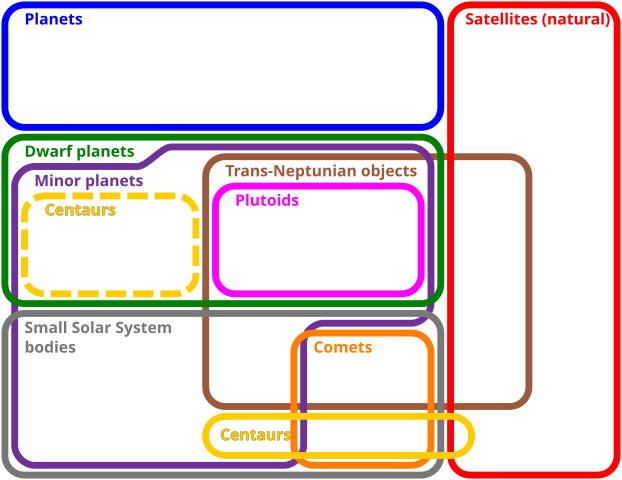
Caption: An Euler diagram showing the relationship between Solar System objects. The Sun and artificial satellites have been excluded.
Features:
- Solar System object keywords
(Solar System object
keywords):
asteroids
(binary asteroids,
near-Earth asteroids (NEAs),
rubble piles,
Trojan asteroids),
astronomical objects (AKA astro-bodies),
centaurs,
comets
(long-period comets,
short-period comets),
dwarf planets,
gas giant planets
(often including the ice giant planets),
ice giant planets,
interplanetary dust,
Kuiper Belt objects (KBOs),
meteoroids,
minor planets,
moons
(minor-planet moon,
moonlet,
subsatellite (moons of moons)),
near-Earth asteroids
(NEAs),
near-Earth objects (NEOs)
(near-Earth asteroids
(NEAs)),
Oort Cloud objects (OCOs),
planetary rings,
planets
(gas giant planets,
terrestrial planets),
potentially hazardous objects (PHOs)
(potentially hazardous asteroids (PHAs)),
Plutoids (AKA TNO dwarf planets),
quasi-satellite (quasi-moon),
rocky bodies,
rocky-icy bodies,
satellite systems (AKA planet-moon systems,
scattered disk objects (SDOs),
small Solar System bodies (SSSBs),
Solar System objects,
spacecraft,
Sun,
terrestrial planets,
trans-Neptunian objects (TNOs),
Trojan asteroids,
vulcanoids (hypothetical),
worlds
(airless worlds),
etc.
- Two kinds of astronomical objects that seem to lack, but badly need, definitions are rocky bodies and rocky-icy bodies. So we define them here:
- rocky body: Vaguely speaking an astronomical object consisting primarily of rock. We use the term rocky to include matter that is It could be carbonaceous (i.e., carbon-rich) and/or iron-rich.
- rocky-icy body: Vaguely speaking an astronomical object consisting primarily of rock and ices, but probably primarily water ice. Besides water ice, other common ices include those of ammonia (NH_3), carbon dioxide (CO_2) (i.e., CO_2 ice (dry ice)), carbon monoxide (CO), methane (CH_4), etc.) nitrogen (N_2),
Obviously there is a continuum between pure rocky bodies and rocky-icy bodies that could be close to pure ices.
In the Solar System, all astronomical objects, except the Sun and the gas giant planets (including the ice giant planets), are rocky bodies and rocky-icy bodies.
Rocky bodies tend to be within the snow line (AKA frost line) (for water ice) and rocky-icy bodies beyond it. The current snow line (which is NOT the same as the snow line at Solar System formation (4.6 Gyr BP)) is ∼ 5 astronomical units (AU) (Wikipedia: Frost line: Current snow line versus formation snow line).
- Two kinds of astronomical objects that seem to lack, but badly need, definitions are rocky bodies and rocky-icy bodies. So we define them here:
Image link: Wikimedia Commons: File:Euler diagram of solar system bodies.svg.
Local file: local link: solar_system_objects.html.
File: Solar System file: solar_system_objects.html.